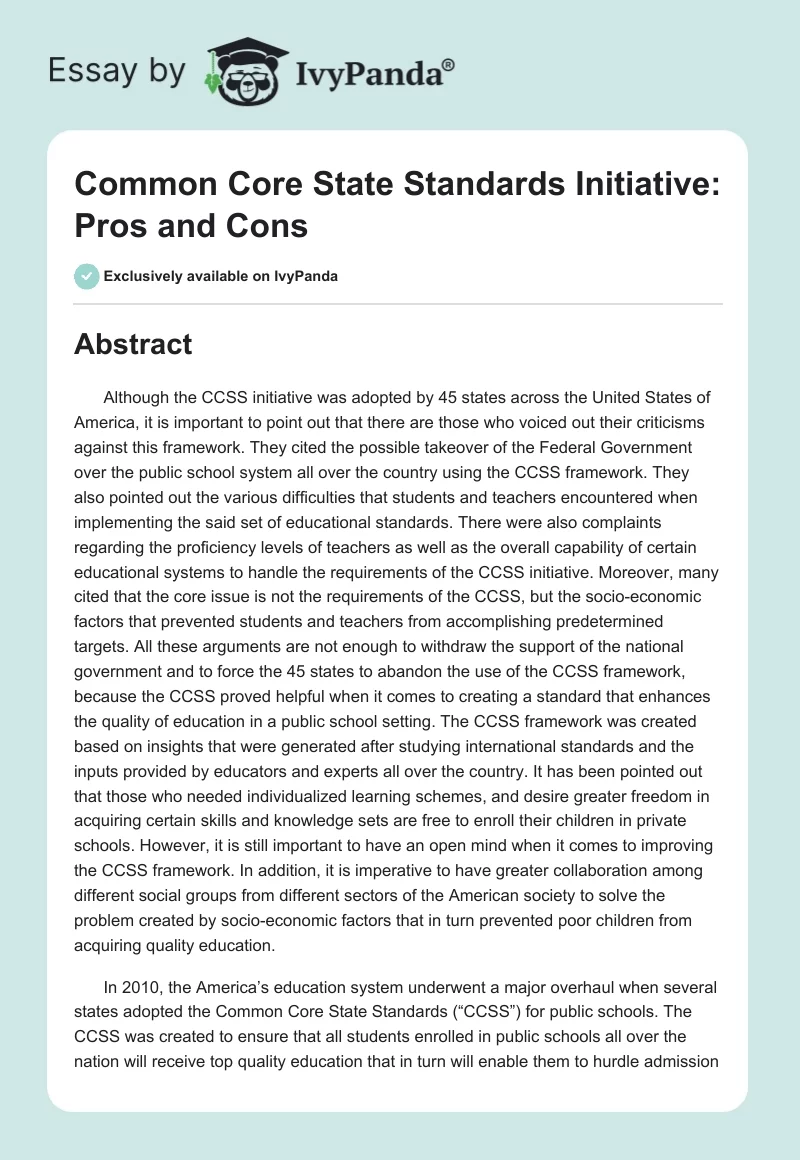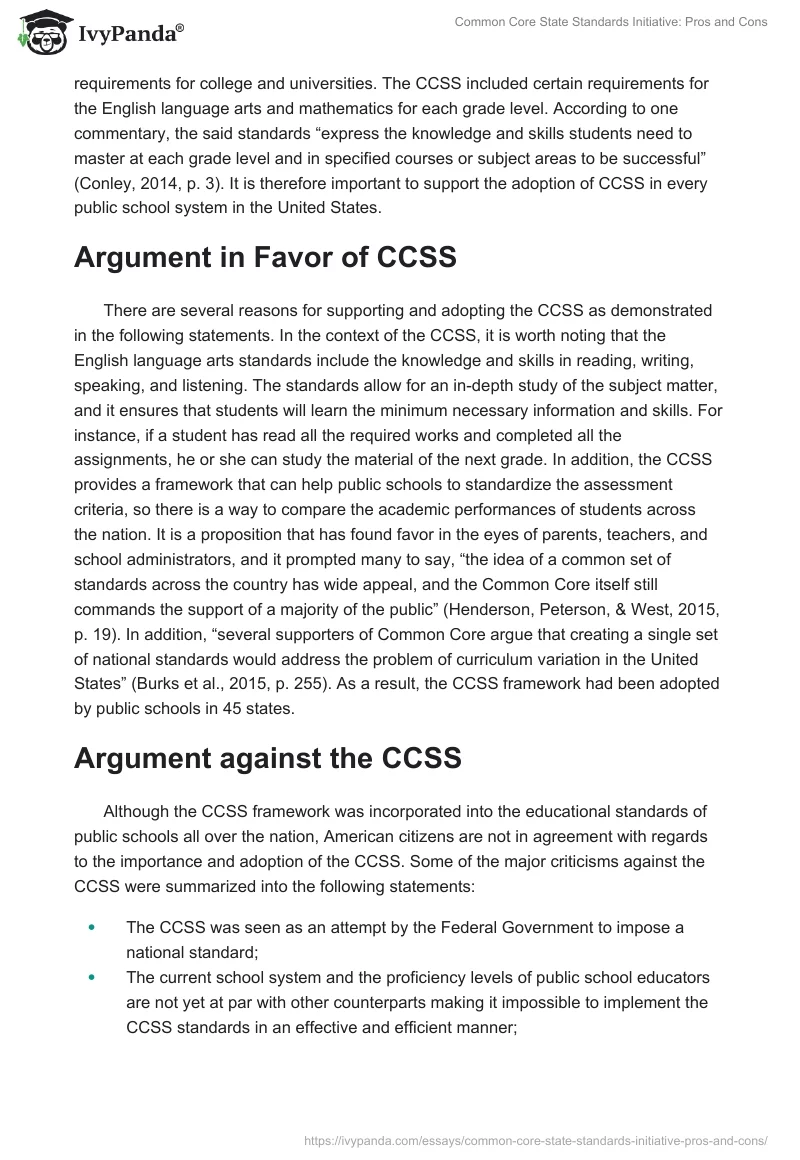Abstract
Although the CCSS initiative was adopted by 45 states across the United States of America, it is important to point out that there are those who voiced out their criticisms against this framework. They cited the possible takeover of the Federal Government over the public school system all over the country using the CCSS framework. They also pointed out the various difficulties that students and teachers encountered when implementing the said set of educational standards. There were also complaints regarding the proficiency levels of teachers as well as the overall capability of certain educational systems to handle the requirements of the CCSS initiative. Moreover, many cited that the core issue is not the requirements of the CCSS, but the socio-economic factors that prevented students and teachers from accomplishing predetermined targets. All these arguments are not enough to withdraw the support of the national government and to force the 45 states to abandon the use of the CCSS framework, because the CCSS proved helpful when it comes to creating a standard that enhances the quality of education in a public school setting. The CCSS framework was created based on insights that were generated after studying international standards and the inputs provided by educators and experts all over the country. It has been pointed out that those who needed individualized learning schemes, and desire greater freedom in acquiring certain skills and knowledge sets are free to enroll their children in private schools. However, it is still important to have an open mind when it comes to improving the CCSS framework. In addition, it is imperative to have greater collaboration among different social groups from different sectors of the American society to solve the problem created by socio-economic factors that in turn prevented poor children from acquiring quality education.
In 2010, the America’s education system underwent a major overhaul when several states adopted the Common Core State Standards (“CCSS”) for public schools. The CCSS was created to ensure that all students enrolled in public schools all over the nation will receive top quality education that in turn will enable them to hurdle admission requirements for college and universities. The CCSS included certain requirements for the English language arts and mathematics for each grade level. According to one commentary, the said standards “express the knowledge and skills students need to master at each grade level and in specified courses or subject areas to be successful” (Conley, 2014, p. 3). It is therefore important to support the adoption of CCSS in every public school system in the United States.
Argument in Favor of CCSS
There are several reasons for supporting and adopting the CCSS as demonstrated in the following statements. In the context of the CCSS, it is worth noting that the English language arts standards include the knowledge and skills in reading, writing, speaking, and listening. The standards allow for an in-depth study of the subject matter, and it ensures that students will learn the minimum necessary information and skills. For instance, if a student has read all the required works and completed all the assignments, he or she can study the material of the next grade. In addition, the CCSS provides a framework that can help public schools to standardize the assessment criteria, so there is a way to compare the academic performances of students across the nation. It is a proposition that has found favor in the eyes of parents, teachers, and school administrators, and it prompted many to say, “the idea of a common set of standards across the country has wide appeal, and the Common Core itself still commands the support of a majority of the public” (Henderson, Peterson, & West, 2015, p. 19). In addition, “several supporters of Common Core argue that creating a single set of national standards would address the problem of curriculum variation in the United States” (Burks et al., 2015, p. 255). As a result, the CCSS framework had been adopted by public schools in 45 states.
Argument against the CCSS
Although the CCSS framework was incorporated into the educational standards of public schools all over the nation, American citizens are not in agreement with regards to the importance and adoption of the CCSS. Some of the major criticisms against the CCSS were summarized into the following statements:
- The CCSS was seen as an attempt by the Federal Government to impose a national standard;
- The current school system and the proficiency levels of public school educators are not yet at par with other counterparts making it impossible to implement the CCSS standards in an effective and efficient manner;
- The CCSS framework is based on a rigid set of standards that limits the learning experience of students;
- The CCSS framework did not consider the need for individualized learning for gifted children and those with special needs; and
- In many cases, it is impossible to implement the said standards due to limitations created by socio-economic factors (VanTassel-Baska, 2015).
It is important to highlight the issue with regards to the common perception that the CCSS is a mechanism that the U.S. government will utilize to control America’s public school system. It is a critical issue because of the way the American government was established, specifically the need to prevent a national government or a political entity to have enough power to compel others to follow a certain set of guidelines even if the said set of standards will benefit only one group of individuals. This concern is the main reason why the United States is currently subdivided into 50 states that are virtually independent of each other. Supporters of the adoption of the CCSS framework must provide an acceptable counter-argument to the claims made by the opponents of the said initiative.
It is also important to address the issue regarding the competence of the public school system and the educators employed within that system. VanTassel-Baska (2015) claims, “the gear-up toward implementation of the CCSS has been slow, uneven across and within states, and fraught with the realities of what schools are ready to do” (p. 61). According to Burks et al. (2015), “the teachers also expressed concern about the amount of training they received in order to implement Common Core in their classrooms” (p. 256). If public schools and public school teachers do not possess the capabilities to implement the standards, then, the CCSS initiative will fail.
It is also important to discuss the perceived limitations created by the implementation of the CCSS. Those who are against the adoption of the CCSS pointed out the need to follow a rigid set of rules, so that there are key areas of learning that were left out. For example, there is an overemphasis of certain literature genres, and therefore, many are wondering if this will have a long-term impact on the overall capabilities of the child. According to one commentary there is a need to infuse creativity in this new system, because students “need to be able to write argumentative essays, understand narrative structures, recognize themes, or indicate explicitly what they have learned” (Vance, 2015, p. 27). The issue on individualized learning becomes more problematic when the learning requirements of gifted children are also considered.
Finally, the impact of socio-economic factors on the implementation of CCSS must be considered. It is not an easy matter to dismiss the grave impact of poverty in the context of a child’s learning capability. It does not require an expert to figure out that even the best educational framework is useless if children in public schools are unable to learn because of poor economic conditions.
Counter-Argument
The issue regarding the perceived takeover by the Federal government does not provide a persuasive argument to end the implementation of the CCSS on a national scale. This assertion is based on the fact that the CCSS was created based on international standards. In addition, the core ideas and standards were created after consulting with various educators all over the country, “state education department staffers, subject-area organizations, and a wide range of interested parties in the general public” (Conley, 2014, p.3). In addition, the inputs of prestigious groups such as the National Assessment Governing Board and the National Council of Teachers of Mathematics were also incorporated into the final draft (Conley, 2014).
The competence of the teachers, as well as the capability of the public school system to implement the CCSS is a legitimate argument; however, it is not an excuse to withdraw support from the said initiative. It is imperative to focus on the benefits of the CCSS with regards to the creation of a basic standard that students and teachers must aspire to reach. The difficulty of the challenge will never form a valid excuse in any debate.
The issue on individualized learning and the need to have greater freedom when it comes to the type of content and the delivery method of teaching skills and knowledge sets must never derail the implementation of the CCSS initiative. This is based on the fact that the CCSS was created for the benefit of the majority of the students enrolled in a public school system. If parents desire an expanded scope of learning, and if they believe that they require a specialized type of learning framework to cater to the needs of a gifted child, then, they are free to enroll their children in private schools.
Although it important to point out that poverty is not a valid excuse to oppose the implementation of the CCSS initiative all over the nation, it is critical to acknowledge the fact that the national government must work with non-government organizations in order to lessen the number of poor families in America. Poverty will affect not only the learning capability but the ability of the student to enroll in a public school (Schoenfeld, 2014).
Conclusion
There was no negative issue that was raised against the CCSS that was valid enough to encourage widespread withdrawal of support. The fears regarding the mechanism for the Federal Government’s takeover of the education system was not founded in facts, because it was pointed out how the CCSS was created in consultation with different sectors of American society. In addition, the problems regarding proficiency levels and difficulty in implementing the CCSS initiative also lacks justification, because American citizens must strive for a higher standard in order to improve the quality of education in public schools. Those who wanted greater freedom in learning are free to enroll their children in private schools. However, the argument against the impact of poverty requires greater scrutiny, because even the best plans are useless if a student is unable to enroll due to poverty. Therefore, there is a need for greater collaboration in educating teachers, parents, school administrators regarding the value of the CCSS initiative in order to generate greater support from different sectors of society, especially from those who want to see significant improvements in the American public school system.
References
Burks, B., Beziat, T., Danley, S., Davis, K., Lowery, H., & Lucas, J. (2015). Adapting to change. Education, 136(2), 253-258.
Conley, D. (2014). Common core. Social Policy Report, 28(2), 2-15.
Henderson, M., Peterson, P., & West, M. (2015). No common opinion on the common core. Education Next, 15(1), 9-19.
Schoenfeld, A. (2014). Common sense about the common core. TME, 11(3), 737-743.
Vance, L. (2015). Should creativity be a common core standard. California English, 21(2), 27-30.
VanTassel-Baska, J. (2015). Arguments for and against the common core state standards. Gifted Child Today, 38(1), 60-62.


